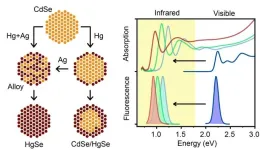(Press-News.org) Researchers from Konstanz have measured the heart rate of bats over several days in the wild, including complete flights—the first time this has been done for a bat species. To record the heart rate of male common noctule bats during flight, the scientists attached heart rate transmitters weighing less than one gram to the animals, which they then accompanied in an airplane while the bats flew, sometimes for more than an hour, in search of food. Their results, published in Proceedings of the Royal Society B, show how much energy bats consume over the course of a day and what energy-saving strategies they use to survive.
Researchers from the Max Planck Institute of Animal Behavior (MPI-AB) and the University of Konstanz used a special method to study male common noctule bats, which are found throughout Europe. Their aim was to understand exactly how much energy bats consume during the day and how this changes over the course of the year.
"Bats are fascinating animals that often share their habitat with us humans," says Lara Keicher, the lead author of the study. "But bats are still shrouded in mystery. We don't yet have a clear answer to simple questions such as: How much food do they need and can they find enough of it in different seasons to survive?" To predict how bats will fare in a changing climate, Keicher says it is crucial to know their energy requirements.
Bats with heart rate transmitters
To find out, the scientists fitted bats with small heart rate transmitters weighing just 0.8 grams. As with humans, heart rate can be used to determine energy consumption. The transmitters, which the bats only wore for a few days, send out an audio signal of the bats' heartbeat, which is then recorded using a radio receiver. However, this only works if the receiver is within a few hundred meters from the bats.
"During the day, it was no problem to record the heart beats without major interruptions because bats were resting in tree caves or bat boxes," says Keicher, who carried out the study as part of her doctoral thesis at the University of Konstanz and the MPI-AB. At night, however, bats fly out to hunt insects and can cover several kilometers in a short time. In order to accompany the bats around the clock, including during their nocturnal flight, the researchers flew in a small airplane to follow individuals for entire flights lasting more than an hour. "I know that we surprised Konstanz locals when our small plane flew in circles over the island of Mainau late at night," recalls Keicher.
Awake during the day
The team, which also included members of the Swiss Institute for Snow and Avalanche Research and the University of Freiburg, found that the heart rate of bats reaches around 900 beats per minute during flight. According to Keicher, who analyzed the signal, "it sounded like a single high-pitched tone to our ears".
Using the unique recordings of heart beats, the scientists discovered fascinating strategies that bats use to budget their energy consumption in different seasons. They found that male common noctule bats consume up to 42% more energy in summer compared to spring. This is mainly due to the fact that the bats in spring go into a kind of short daytime hibernation known as “torpor”—an energy-saving state in which heart rate can be reduced to six beats per minute. “We saw that bats in spring could ramp up their heart rates when they wake up, reaching the top speed of 900 beats per minute within only a few minutes,” says Keicher.
The team was surprised that male bats did not use torpor in summer at all. Keicher explains: “In the warmer months, when food is plentiful, males stay awake during the day to invest energy in sperm production in order to be ready for mating in the autumn." To replenish the energy used up, the males hunt twice as long in summer as in spring and eat up to 33 June beetles or over 2500 mosquitoes in one night.
The results have provided insights into the energetic challenges of bats and their fascinating survival strategies. This understanding will allow better predictions of how increasingly extreme temperature fluctuations or changes in food availability will affect the animals' lives and potentially threaten them.
The senior author of the study, MPI-AB scientist Dina Dechmann, says: "All bat species are protected in Germany and some are threatened with extinction. Basic research that investigates the behavior of the animals and their adaptations to the environment can help us develop protective measures so that, for example, common noctule bats can continue to be seen in the night sky over Konstanz."
A YouTube video with audio of heart beats recorded from bats is here: https://youtu.be/l-C4vuyXZug?si=Bci81JZnMDDT8vUK
END
Researchers listen to the hearts of bats in flight
Unique recordings show that bats can ramp up heart rate from 6 to 900 b.p.m within minutes
2024-07-10
ELSE PRESS RELEASES FROM THIS DATE:
Familial endocrine diseases linked to increased risk of pregnancy loss, new research shows
2024-07-10
Women who have close family members with endocrine diseases, including type 2 diabetes, thyroid diseases and polycystic ovary syndrome (PCOS), are at higher risk of pregnancy loss, a new study has found [1].
The research, presented today at the ESHRE 40th Annual Meeting in Amsterdam, examined the association between various endocrine diseases and the incidence of pregnancy loss. The study investigated 366,539 women in Denmark between 1973 and 2022.
The study found that women with parents diagnosed with endocrine diseases faced a 6% higher risk of pregnancy loss ...
Health AI expert Nathan Price joins Buck faculty
2024-07-09
The Buck Institute for Research on Aging announces the appointment of Nathan Price, PhD, to Professor and Co-Director of the Center for Human Healthspan. Price specializes in systems biology, artificial intelligence, and bioengineering. He has published more than 200 scientific papers and is co-author, with Buck Chief Innovation Officer and Distinguished Professor Lee Hood, of “The Age of Scientific Wellness.” Price has been named one of 10 Emerging Leaders in Health and Medicine by the National Academy of Medicine and is a member of the Board on Life Sciences of the National Academies of Sciences, Engineering, and Medicine.
Dr. Price is Chief Scientific Officer ...
Greater focus needed on how existing international law can prevent the increasing militarisation of outer space
2024-07-09
There is a pressing need for countries and international organisations to understand better how existing international law can help them address serious concerns about the militarisation of outer space, a new study says.
Space ...
Found with Webb: a potentially habitable icy world
2024-07-09
A international team of astronomers led by Université de Montréal has made an exciting discovery about the temperate exoplanet LHS 1140 b: it could be a promising "super-Earth" covered in ice or water.
When the exoplanet LHS 1140 b was first discovered, astronomers speculated that it might be a mini-Neptune: an essentially gaseous planet, but very small in size compared to Neptune. But after analyzing data from the James Webb Space Telescope (JWST) collected in December 2023 - combined with previous data from other space telescopes such as Spitzer, Hubble and ...
New one-step method to make multiple edits to a cell’s genome
2024-07-09
SAN FRANCISCO, CA—Genome editing has become a widely adopted technology to modify DNA in cells, allowing scientists to study diseases in the lab and develop therapies that repair disease-causing mutations. However, with current approaches, it’s only possible to edit cells in one location at a time.
Now, a team of scientists at Gladstone Institutes has developed a new method that enables them to make precise edits in multiple locations within a cell—all at once. Using molecules called retrons, they created a tool that can efficiently modify DNA in bacteria, yeast, and human cells.
“We wanted to push the boundaries of genomic technologies ...
Moving from the visible to the infrared: Developing high quality nanocrystals
2024-07-09
Awarded the 2023 Nobel Prize in Chemistry, quantum dots have a wide variety of applications ranging from displays and LED lights to chemical reaction catalysis and bioimaging. These semiconductor nanocrystals are so small—on the order of nanometers—that their properties, such as color, are size dependent, and they start to exhibit quantum properties. This technology has been really well developed, but only in the visible spectrum, leaving untapped opportunities for technologies in both the ultraviolet and infrared regions of the electromagnetic ...
Implantable LED device uses light to treat deep-seated cancers
2024-07-09
Certain types of light have proven to be an effective, minimally invasive treatment for cancers located on or near the skin when combined with a light-activated drug. But deep-seated cancers, surrounded by tissue, blood and bone, have been beyond the reach of light’s therapeutic effects.
To bring light’s benefits to these harder-to-access cancers, engineers and scientists at the University of Notre Dame have devised a wireless LED device that can be implanted. This device, when combined with a light-sensitive ...
LA County faces dual challenge: Food insecurity and nutrition insecurity
2024-07-09
While food insecurity has long been the focus of local and national policymakers and researchers, nutrition insecurity has largely been overlooked. A new study by the Institute for Food System Equity (IFSE) at the USC Dornsife College of Letters, Arts and Sciences aims to change that.
This is the first study in Los Angeles County to identify the populations most affected by nutrition insecurity, distinct from food insecurity. Nutrition insecurity refers to a lack of access to healthy food that ...
AI can support humanitarian organizations in situations of armed conflict or crisis - but they should understand the potential risks, study warns
2024-07-09
AI can help humanitarians gain crucial insights to better monitor and anticipate risks, such as a conflict outbreak or escalation. But deploying systems in this context is not without risks for those affected, a new study warns.
Humanitarian organisations have been increasingly using digital technologies and the Covid-19 pandemic has accelerated this trend.
AI-supported disaster mapping was used in Mozambique to speed up emergency response, and AI systems were used to predict food crisis and rolled out by the World Bank across twenty-one countries.
But the study warns some uses of AI may expose people to additional harms and present significant ...
Speech Accessibility Project’s three newest partners are dedicated to people with cerebral palsy
2024-07-09
The Speech Accessibility Project is partnering with several organizations who serve people with cerebral palsy as it recruits more participants for its speech recognition technology work. They include ADAPT Community Network, the Cerebral Palsy Foundation and CP Unlimited.
The project is recruiting U.S. and Puerto Rican adults with cerebral palsy, amyotrophic lateral sclerosis, Down syndrome, Parkinson’s and those who have had a stroke. Funded by Big ...
LAST 30 PRESS RELEASES:
First Editorial of 2026: Resisting AI slop
Joint ground- and space-based observations reveal Saturn-mass rogue planet
Inheritable genetic variant offers protection against blood cancer risk and progression
Pigs settled Pacific islands alongside early human voyagers
A Coral reef’s daily pulse reshapes microbes in surrounding waters
EAST Tokamak experiments exceed plasma density limit, offering new approach to fusion ignition
Groundbreaking discovery reveals Africa’s oldest cremation pyre and complex ritual practices
First breathing ‘lung-on-chip’ developed using genetically identical cells
How people moved pigs across the Pacific
Interaction of climate change and human activity and its impact on plant diversity in Qinghai-Tibet plateau
From addressing uncertainty to national strategy: an interpretation of Professor Lim Siong Guan’s views
Clinical trials on AI language model use in digestive healthcare
Scientists improve robotic visual–inertial trajectory localization accuracy using cross-modal interaction and selection techniques
Correlation between cancer cachexia and immune-related adverse events in HCC
Human adipose tissue: a new source for functional organoids
Metro lines double as freight highways during off-peak hours, Beijing study shows
Biomedical functions and applications of nanomaterials in tumor diagnosis and treatment: perspectives from ophthalmic oncology
3D imaging unveils how passivation improves perovskite solar cell performance
Enriching framework Al sites in 8-membered rings of Cu-SSZ-39 zeolite to enhance low-temperature ammonia selective catalytic reduction performance
AI-powered RNA drug development: a new frontier in therapeutics
Decoupling the HOR enhancement on PtRu: Dynamically matching interfacial water to reaction coordinates
Sulfur isn’t poisonous when it synergistically acts with phosphine in olefins hydroformylation
URI researchers uncover molecular mechanisms behind speciation in corals
Chitin based carbon aerogel offers a cleaner way to store thermal energy
Tracing hidden sources of nitrate pollution in rapidly changing rural urban landscapes
Viruses on plastic pollution may quietly accelerate the spread of antibiotic resistance
Three UH Rainbow Babies & Children’s faculty elected to prestigious American Pediatric Society
Tunnel resilience models unveiled to aid post-earthquake recovery
Satellite communication systems: the future of 5G/6G connectivity
Space computing power networks: a new frontier for satellite technologies
[Press-News.org] Researchers listen to the hearts of bats in flightUnique recordings show that bats can ramp up heart rate from 6 to 900 b.p.m within minutes







